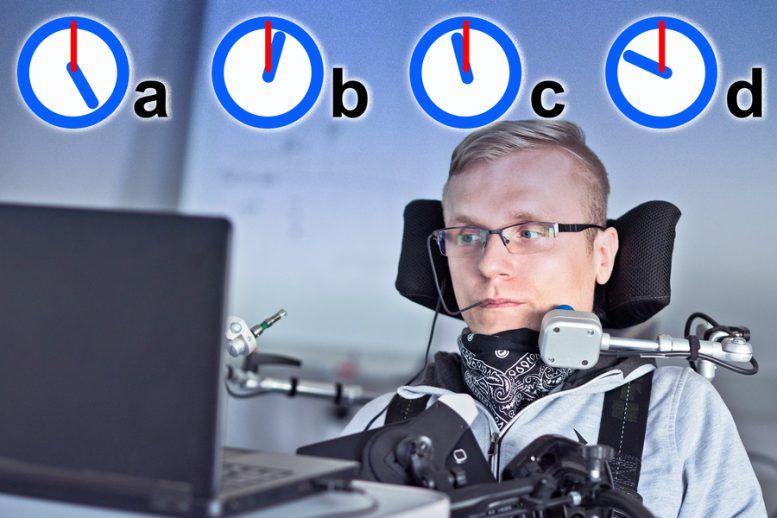
Researchers at MIT and elsewhere are developing a system that enables severely motor-impaired individuals who communicate using a single switch to do so faster and with more accuracy. Their system is more flexible than many common interfaces, enabling it to be used for tasks like drawing, gaming, or surfing the web. Credit: Clock figures courtesy of the researchers, photo via iStockphoto
For individuals who communicate using a single switch, a new interface learns how they make selections, and then self-adjusts accordingly.
In 1995, French fashion magazine editor Jean-Dominique Bauby suffered a seizure while driving a car, which left him with a condition known as locked-in syndrome, a neurological disease in which the patient is completely paralyzed and can only move muscles that control the eyes.
Bauby, who had signed a book contract shortly before his accident, wrote the memoir “The Diving Bell and the Butterfly” using a dictation system in which his speech therapist recited the alphabet and he would blink when she said the correct letter. They wrote the 130-page book one blink at a time.
Technology has come a long way since Bauby’s accident. Many individuals with severe motor impairments caused by locked-in syndrome, cerebral palsy, amyotrophic lateral sclerosis, or other conditions can communicate using computer interfaces where they select letters or words in an onscreen grid by activating a single switch, often by pressing a button, releasing a puff of air, or blinking.
But these row-column scanning systems are very rigid, and, similar to the technique used by Bauby’s speech therapist, they highlight each option one at a time, making them frustratingly slow for some users. And they are not suitable for tasks where options can’t be arranged in a grid, like drawing, browsing the web, or gaming.
A more flexible system being developed by researchers at 
In the Nomon interface, a small analog clock is placed next to every option the user can select. (A gnomon is the part of a sundial that casts a shadow.) Here is an example of the interface being used as a keyboard.Credit: Image courtesy of the researchers.
Adapting to noisy clicks
With its probabilistic reasoning, Nomon incorporates everything it knows about where a user is likely to click to make the process faster, easier, and less error-prone. For instance, if the user selects “Q,” Nomon will make it as easy as possible for the user to select “U” next.
Nomon also learns how a user clicks. So, if the user always clicks a little after the clock’s hand strikes noon, the system adapts to that in real time. It also adapts to noisiness. If a user’s click is often off the mark, the system requires extra clicks to ensure accuracy.
This probabilistic reasoning makes Nomon powerful but also requires a higher click-load than row-column scanning systems. Clicking multiple times can be a trying task for severely motor-impaired users.
Broderick hopes to reduce the click-load by incorporating gaze tracking into Nomon, which would give the system more robust information about what a user might choose next based on which part of the screen they are looking at. The researchers also want to find a better way to automatically adjust the clock speeds to help users be more accurate and efficient.
They are working on a new series of studies in which they plan to partner with more motor-impaired users.
“So far, the feedback from motor-impaired users has been invaluable to us; we’re very grateful to the motor-impaired user who commented on our initial interface and the separate motor-impaired user who participated in our study. We’re currently extending our study to work with a bigger and more diverse group of our target population. With their help, we’re already making further improvements to our interface and working to better understand the performance of Nomon,” she says.
“Nonspeaking individuals with motor disabilities are currently not provided with efficient communication solutions for interacting with either speaking partners or computer systems. This ‘communication gap’ is a known unresolved problem in human-computer interaction, and so far there are no good solutions. This paper demonstrates that a highly creative approach underpinned by a statistical model can provide tangible performance gains to the users who need it the most: nonspeaking individuals reliant on a single switch to communicate,” says Per Ola Kristensson, professor of interactive systems engineering at Cambridge University, who was not involved with this research. “The paper also demonstrates the value of complementing insights from computational experiments with the involvement of end-users and other stakeholders in the design process. I find this a highly creative and important paper in an area where it is notoriously difficult to make significant progress.”
This research was supported, in part, by the Seth Teller Memorial Fund to Advanced Technology for People with Disabilities, a Peter J. Eloranta Summer Undergraduate Research Fellowship, the MIT Quest for Intelligence, and the National Science Foundation.
I may need your help. I’ve been doing research on gate io recently, and I’ve tried a lot of different things. Later, I read your article, and I think your way of writing has given me some innovative ideas, thank you very much.
jazz piano music